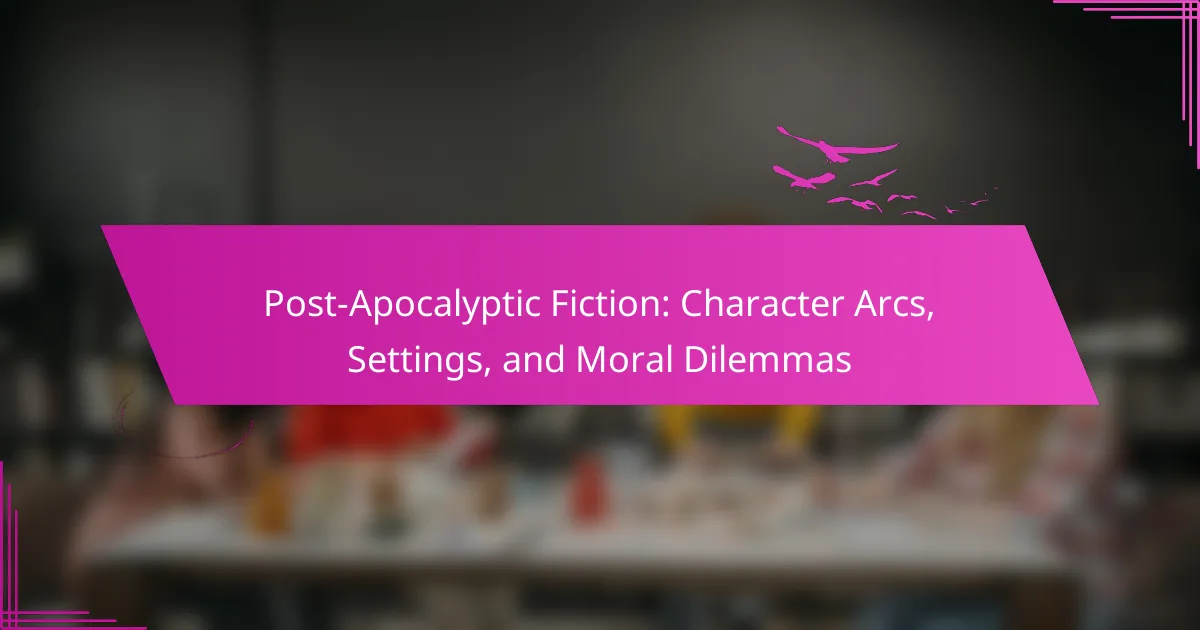Post-apocalyptic fiction captivates readers by exploring survival-driven character arcs, desolate settings, and complex moral dilemmas. Characters undergo significant transformations as they navigate harsh environments and face ethical choices that challenge their humanity. The interplay between character development and setting creates a rich narrative that reflects societal values and fears. This genre prompts readers to consider the implications of individual actions and collective responsibility in extreme circumstances.
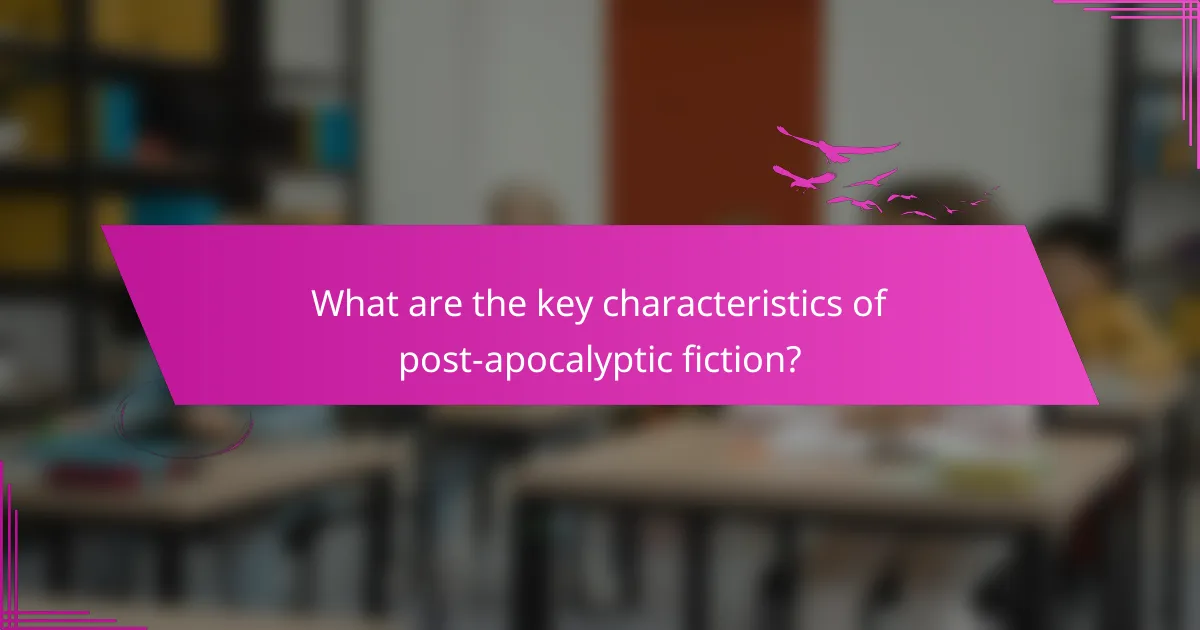
What are the key characteristics of post-apocalyptic fiction?
Post-apocalyptic fiction features distinct characteristics that shape its narrative. Key elements include desolate settings, survival-driven character arcs, and moral dilemmas that challenge human nature.
Desolate settings often depict a world ravaged by disaster, creating a backdrop that influences characters’ motivations. Characters typically undergo significant transformations, facing ethical choices that explore themes of humanity, trust, and survival.
Moral dilemmas serve as critical turning points, forcing characters to confront their values and beliefs. These conflicts enhance tension and engagement, prompting readers to reflect on societal norms and individual choices in extreme circumstances.
Overall, post-apocalyptic fiction captivates by merging bleak environments with profound character development and ethical questions.
How do character arcs evolve in post-apocalyptic narratives?
Character arcs in post-apocalyptic narratives evolve through trauma, survival instincts, and moral dilemmas. Characters often undergo significant transformations as they face extreme challenges. Initially, they may exhibit selfishness or fear, but as the story progresses, they often develop resilience and empathy.
This evolution is influenced by their interactions with other survivors, which can lead to alliances or conflicts. For example, a character who starts as a lone wolf may learn the value of community and cooperation. The harsh realities of their environment force them to confront their values and make difficult choices, shaping their growth.
Furthermore, unique attributes of these narratives, such as the collapse of societal norms, amplify the stakes. Characters often grapple with ethical dilemmas that challenge their morality, leading to profound personal change. As a result, the character arc becomes a reflection of the broader themes of humanity and survival in a world stripped of civilization.
What settings are commonly depicted in post-apocalyptic fiction?
Common settings in post-apocalyptic fiction include desolate cities, barren landscapes, and isolated communities. These environments often highlight themes of survival and human resilience.
Desolate cities showcase the remnants of civilization, emphasizing decay and abandonment. Barren landscapes, such as deserts or wastelands, illustrate the harshness of the new world. Isolated communities often depict the struggle for resources and the formation of new social structures.
Each setting serves to deepen the narrative, presenting unique challenges and moral dilemmas faced by characters in their quest for survival.
What moral dilemmas arise in post-apocalyptic scenarios?
Post-apocalyptic scenarios often present complex moral dilemmas that challenge characters’ ethics. Key dilemmas include survival versus morality, where characters must choose between their own survival and the well-being of others. Trust becomes a significant issue, as characters grapple with whom to trust in a world where betrayal is common. The scarcity of resources leads to difficult decisions about sharing and hoarding, raising questions about fairness and community. Additionally, the loss of societal norms forces characters to redefine their values, often leading to conflicts between personal beliefs and the harsh realities of survival.
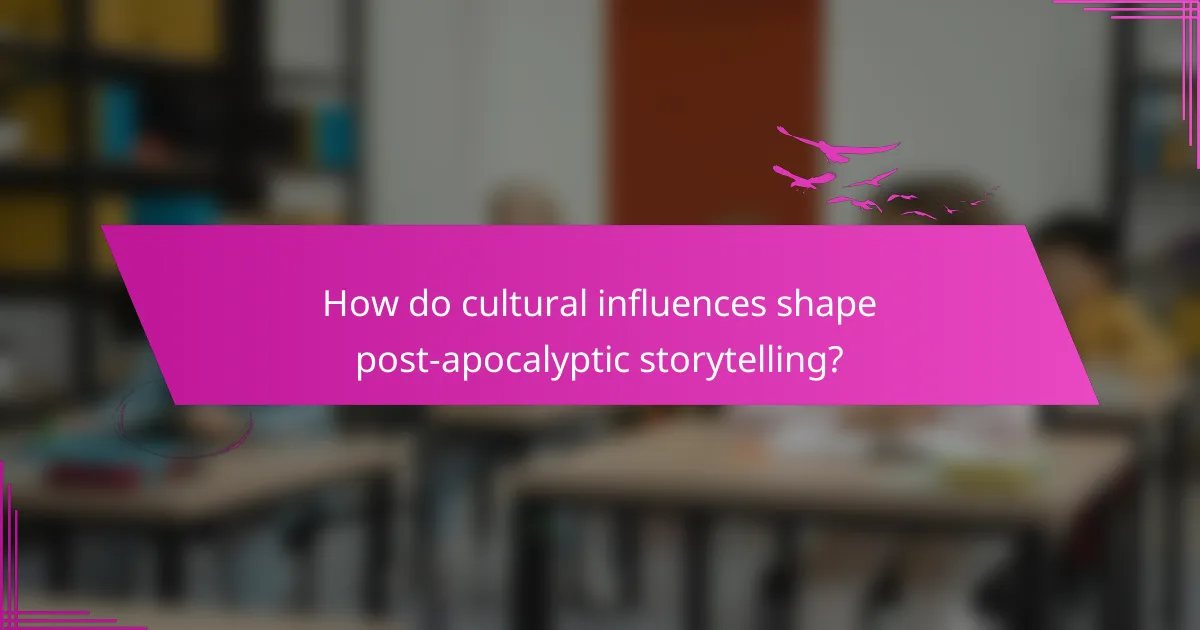
How do cultural influences shape post-apocalyptic storytelling?
Cultural influences significantly shape post-apocalyptic storytelling by reflecting societal values and fears. Different cultures introduce unique character arcs, settings, and moral dilemmas that resonate with their audiences. For instance, Western narratives often emphasize individualism and survival, while Eastern stories may focus on community and collective resilience.
The portrayal of moral dilemmas varies across cultures, highlighting distinct ethical frameworks. In some narratives, characters face choices that test loyalty and sacrifice, while others explore the consequences of power and governance in a collapsed society.
Additionally, settings in post-apocalyptic fiction can reflect cultural landscapes, transforming familiar environments into dystopian backdrops. This transformation often serves to critique contemporary societal issues, such as environmental degradation or political unrest.
Ultimately, cultural influences enrich post-apocalyptic storytelling by providing diverse perspectives that challenge readers to consider their own values and beliefs in the face of adversity.
Which themes resonate with audiences in North America?
Post-apocalyptic fiction resonates with North American audiences through themes of survival, moral ambiguity, and societal collapse. Character arcs often explore resilience and transformation amid chaos. Settings frequently depict desolate landscapes, emphasizing isolation and loss. Moral dilemmas challenge characters to navigate ethical choices in a world devoid of order.
How do European narratives differ in their portrayal of post-apocalyptic worlds?
European narratives often emphasize societal collapse and moral ambiguity in post-apocalyptic worlds, differing from other portrayals. They frequently explore themes of community and survival, focusing on character arcs that reflect cultural values. For example, European fiction often highlights the struggle for identity amidst chaos, showcasing unique attributes like philosophical introspection and ethical dilemmas. Settings may feature decaying urban landscapes, symbolizing lost civilization, which contrasts with more action-driven American narratives. This nuanced portrayal invites readers to ponder the implications of humanity’s choices in dire circumstances.

What role do protagonists play in driving the narrative forward?
Protagonists in post-apocalyptic fiction drive the narrative by embodying conflict and moral dilemmas. Their character arcs reflect personal growth and resilience, often in response to extreme circumstances. As they navigate desolate settings, protagonists face ethical choices that challenge their values, propelling the story forward. Their decisions impact not only their survival but also the fate of others, creating a dynamic interplay between individual actions and broader societal themes. This engagement with moral complexity enriches the narrative, making the protagonist’s journey central to the reader’s experience.
How do antagonists challenge the protagonists in these stories?
Antagonists challenge protagonists in post-apocalyptic fiction by embodying moral dilemmas and survival conflicts. They often represent opposing ideologies, forcing protagonists to confront their beliefs and choices. For instance, a ruthless antagonist may prioritize survival at any cost, pushing the protagonist to question their ethics. This dynamic creates tension and drives character development, as protagonists must adapt to overcome these formidable challenges. Additionally, antagonists can symbolize the consequences of societal collapse, highlighting themes of human nature and resilience. Ultimately, these confrontations shape the protagonists’ arcs and the narrative’s moral landscape.
What makes a compelling character arc in a survival context?
A compelling character arc in a survival context showcases transformation through adversity. Characters evolve as they face extreme challenges, revealing their resilience and moral dilemmas. Effective arcs balance internal conflict with external threats, highlighting growth and change. This evolution often includes a shift in values or beliefs, making the character relatable and engaging.

In what ways do settings influence character development?
Settings profoundly shape character development by creating unique challenges and moral dilemmas. In post-apocalyptic fiction, harsh environments force characters to adapt, revealing their true nature. The struggle for survival often leads to profound transformations, as characters confront ethical choices that define their arcs. Settings also influence relationships, as characters bond or clash based on shared experiences in their desolate world. This interplay between character and setting enhances the narrative depth, making the exploration of human resilience and morality more compelling.
How do urban versus rural settings affect plot dynamics?
Urban and rural settings profoundly influence plot dynamics in post-apocalyptic fiction. Urban environments often present claustrophobic challenges, heightening tension through limited resources and increased conflict. In contrast, rural settings allow for expansive landscapes, fostering themes of isolation and survival.
Character arcs differ significantly; urban characters may adapt to rapid changes and chaos, while rural characters often rely on resilience and resourcefulness. Moral dilemmas also vary; urban plots might explore ethical choices in crowded spaces, while rural narratives often focus on survival ethics in vast, untamed territories.
These contrasting settings shape the narrative’s tone, pacing, and character development, ultimately affecting reader engagement and thematic depth.
What unique features do dystopian environments bring to the narrative?
Dystopian environments create unique features that enhance narrative depth. They often establish a stark contrast between the past and present, emphasizing loss and survival. These settings foster complex character arcs as individuals navigate moral dilemmas, often challenging their values and beliefs. Additionally, they serve as a backdrop for exploring societal issues, reflecting fears about technology, governance, and human nature. This interplay of environment and character development amplifies the emotional stakes, making the narrative more compelling.

What are the most common moral dilemmas faced by characters?
Characters in post-apocalyptic fiction frequently face moral dilemmas that test their ethics and humanity. Common dilemmas include choosing between survival and compassion, betraying allies for personal gain, and deciding whether to sacrifice one for the many. These conflicts often highlight the struggle between individual needs and collective responsibility. As a result, characters evolve through their choices, reflecting the harsh realities of their environments.
How do survival instincts conflict with ethical considerations?
Survival instincts often clash with ethical considerations in post-apocalyptic fiction. Characters face dilemmas where survival may necessitate actions that violate moral codes. For example, a character might choose to betray a companion to secure resources, highlighting the struggle between self-preservation and loyalty. This conflict enriches character arcs and deepens the narrative, showcasing how extreme circumstances can distort ethical beliefs. Ultimately, such scenarios provoke readers to reflect on their own values in the face of adversity.
What choices do characters make when faced with limited resources?
Characters in post-apocalyptic fiction often make choices that reflect their values and survival instincts when faced with limited resources. They may prioritize self-preservation over moral considerations, leading to ethical dilemmas. For instance, a character might choose to steal food to survive, highlighting the tension between survival and morality.
Additionally, characters may form alliances to pool resources, demonstrating adaptability in dire situations. They often face unique challenges that require innovative problem-solving, such as finding alternative food sources or creating makeshift shelters. These decisions significantly shape their character arcs and moral development throughout the narrative.
Ultimately, the choices characters make in these scenarios reveal their core attributes, such as resilience, empathy, or ruthlessness, which are essential for navigating a world stripped of societal norms.
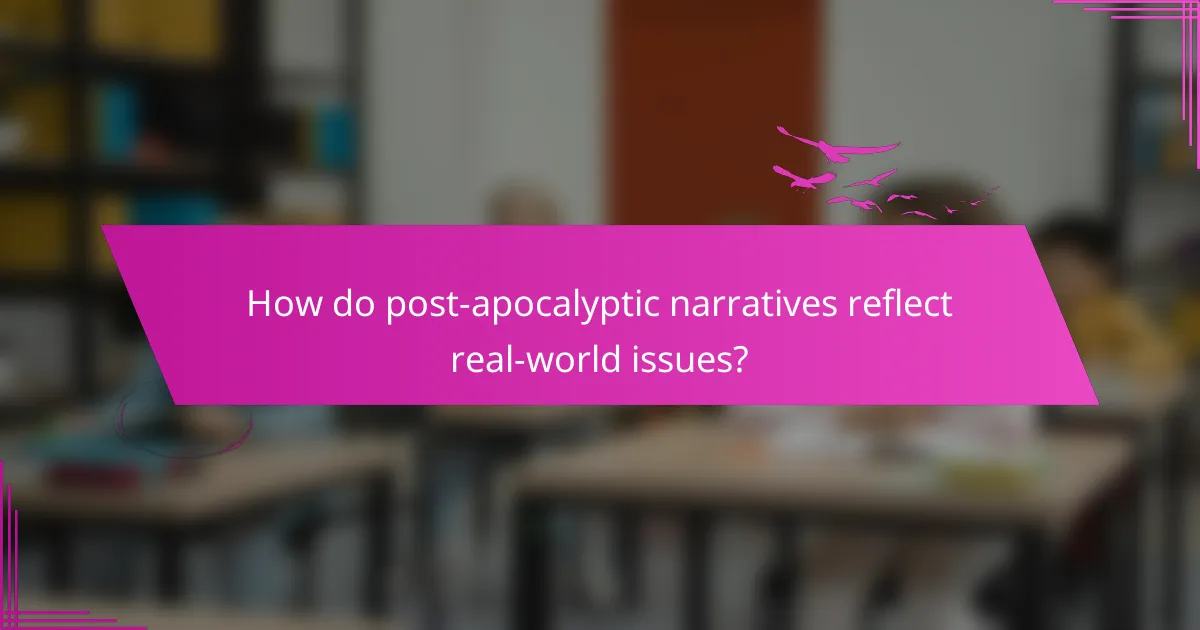
How do post-apocalyptic narratives reflect real-world issues?
Post-apocalyptic narratives often mirror real-world issues by exploring themes like survival, societal collapse, and moral dilemmas. These stories highlight human resilience and the consequences of environmental neglect. For example, they can critique governmental failures or social inequalities, reflecting contemporary anxieties about climate change and resource scarcity. Characters often face ethical choices that challenge their humanity, revealing how crises can reshape moral compasses. Such narratives serve as cautionary tales, urging reflection on current societal structures and behaviors.
What parallels can be drawn between fiction and contemporary societal challenges?
Post-apocalyptic fiction often mirrors contemporary societal challenges by exploring themes of survival, morality, and human resilience. Characters face moral dilemmas that reflect real-world ethical conflicts, emphasizing the struggle between individual needs and community welfare. Settings in these narratives frequently depict societal collapse, prompting readers to confront issues like climate change, political instability, and resource scarcity. This genre serves as a lens through which we can examine our responses to crises, showcasing both the darkness and hope that arise in times of adversity.
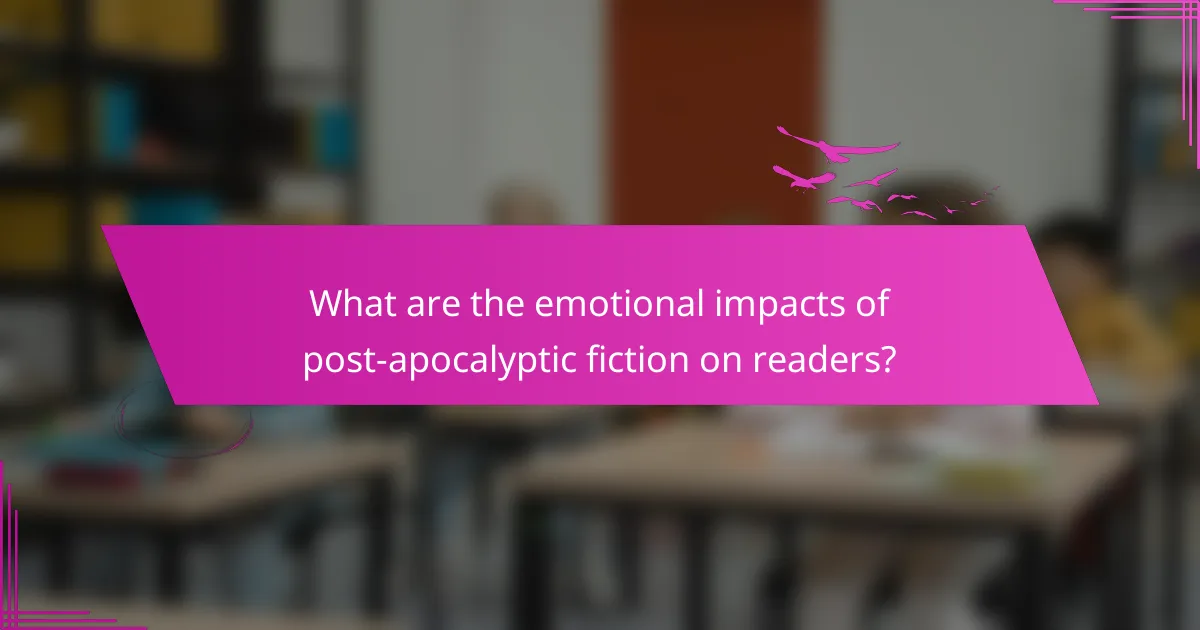
What are the emotional impacts of post-apocalyptic fiction on readers?
Post-apocalyptic fiction profoundly impacts readers’ emotions by evoking feelings of fear, hope, and resilience. These narratives often explore character arcs that highlight personal growth amid chaos, fostering empathy and reflection. Settings in desolate worlds amplify feelings of isolation, yet they also inspire appreciation for survival and community. Moral dilemmas presented challenge readers to confront their values, prompting introspection about humanity’s fragility and strength.
How do readers relate to characters’ struggles and triumphs?
Readers connect deeply with characters’ struggles and triumphs through shared experiences and emotional resonance. In post-apocalyptic fiction, characters often face extreme moral dilemmas, mirroring real-life challenges. This relatability enhances reader engagement and investment in character arcs. Characters’ resilience and growth in dire settings reflect universal themes of survival and hope, making their journeys compelling. As a result, readers often find inspiration and reflection in these narratives, fostering a strong emotional bond with the characters.
What psychological themes emerge from the exploration of loss and survival?
Exploration of loss and survival in post-apocalyptic fiction reveals themes of resilience, identity, and moral ambiguity. Characters often undergo profound transformations as they navigate grief and adapt to harsh realities.
Survival drives ethical dilemmas, challenging characters to choose between personal gain and communal welfare. The struggle against loss fosters connections, highlighting the importance of relationships amidst devastation.
Unique character arcs emerge, showcasing varied responses to trauma, from despair to empowerment. Settings amplify psychological themes, with desolate landscapes symbolizing internal struggles.
Ultimately, these narratives reflect human capacity for hope and adaptation in the face of overwhelming adversity.
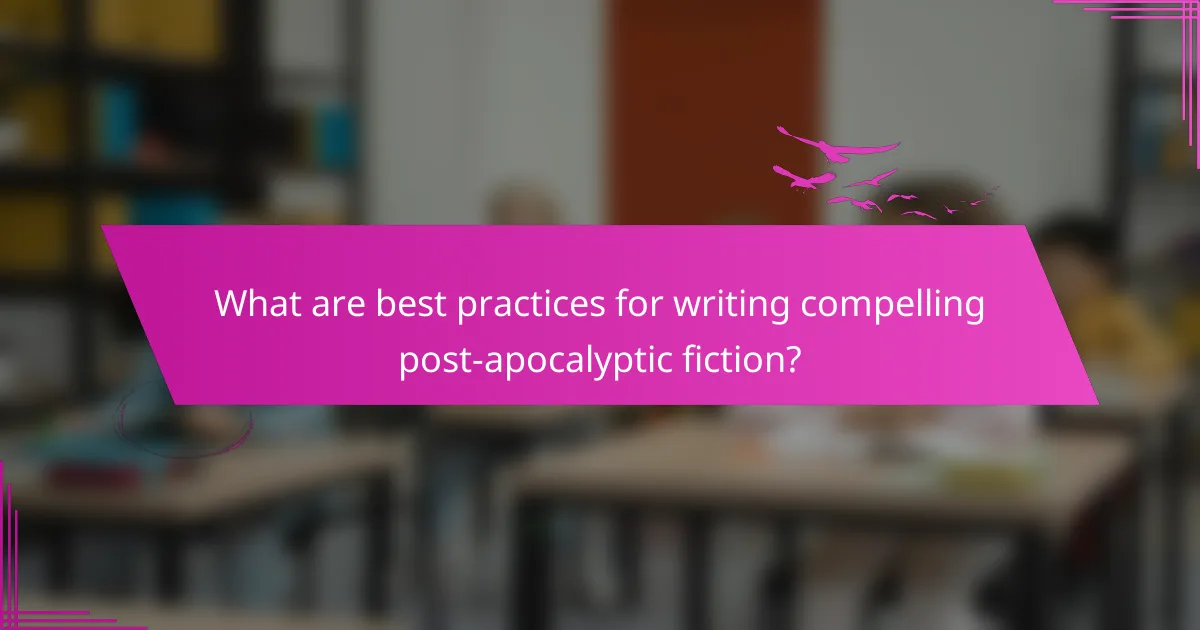
What are best practices for writing compelling post-apocalyptic fiction?
To write compelling post-apocalyptic fiction, focus on deep character arcs, immersive settings, and complex moral dilemmas. Characters should evolve through their experiences, reflecting the harsh realities of their world. Create vivid settings that enhance the narrative, using unique attributes like desolate landscapes or remnants of civilization. Incorporate moral dilemmas that challenge characters’ beliefs, forcing them to make tough choices that resonate with the reader. These elements will engage your audience and enrich the story.
What common mistakes should writers avoid in character development?
Writers in post-apocalyptic fiction should avoid common mistakes that undermine character development. Failing to create distinct character arcs can lead to flat characters. Neglecting to establish clear motivations may confuse readers about character actions. Overloading characters with clichés can make them unrelatable. Ignoring the impact of the setting on character behavior diminishes realism. Lastly, overlooking moral dilemmas can strip characters of depth and complexity, essential in a post-apocalyptic context.
How can authors effectively balance action with moral complexity?
Authors can balance action with moral complexity by integrating character-driven narratives that challenge ethical boundaries. They should develop multidimensional characters facing dilemmas that resonate with readers. This approach enhances the tension between survival instincts and moral choices, making the story compelling.
In post-apocalyptic fiction, settings often strip away societal norms, forcing characters to confront their values. This backdrop allows for exploration of unique attributes, such as personal sacrifice and loyalty, which can enrich the narrative. By weaving these elements together, authors create a nuanced portrayal of human behavior in extreme circumstances.
Additionally, pacing is crucial. Alternating between high-stakes action and reflective moments can maintain reader engagement while allowing for moral contemplation. This balance can deepen character arcs and emphasize the consequences of their decisions, reinforcing the theme of moral complexity.
Overall, effective storytelling in this genre requires a careful blend of dynamic action sequences and profound ethical inquiries, ensuring that both elements enhance the reader’s experience.
What strategies enhance world-building in post-apocalyptic settings?
Effective strategies for enhancing world-building in post-apocalyptic settings include creating rich backstories, developing unique cultures, and establishing clear rules for survival. Backstories provide context for the current state of the world, while unique cultures showcase how humanity adapts. Clear survival rules add realism and tension, driving character decisions. Integrating these elements deepens the narrative and engages readers.
